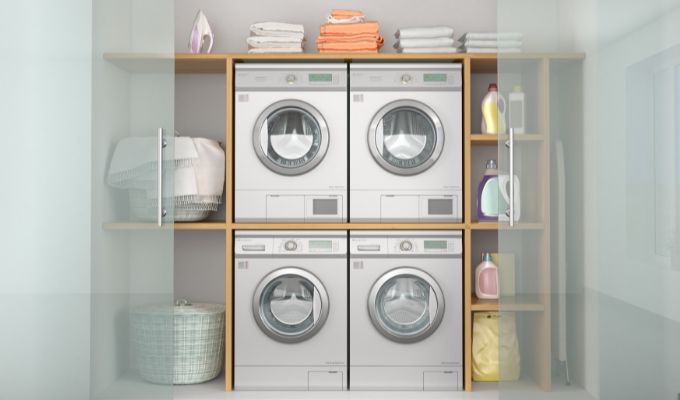Tumble dryers are a gentle, quick, and efficient way to dry wet fabrics. What was once an expensive luxury is now an affordable appliance found in most homes. If you don’t shop smart, they can push your smart meter into the red with their high energy consumption.
This common laundry appliance replaces the indoor drying rack and is the ideal companion to the washing machine. Making life much easier for busy households, the tumble dryer saves us a ton of time on drying washings.
Although tumble dryers have a solid reputation and encompass modern styling, they are often referred to as pricey power guzzlers. However, this is only true to a degree; newer models utilising less power while providing better drying performance are not as heavy on power consumption as you might think.
Many brands now offer numerous functionalities and programmes specifically designed to maximize energy efficiency. You may be surprised to know that dryer energy efficiency classes start at A+++, which allows families to enjoy the benefits of a tumble dryer without having too much of an impact on electricity bills.
Here are our top picks ranked for the best energy efficiency ratings.
1. Best Overall: Haier HD90-A2959

This cutting-edge Haier range combines power and time savings with professional results. You can oversee your I-Pro Series 5 Tumble Dryer from anywhere and at any time, thanks to the incredible remote control provided by the hOn App.
The new Hygiene feature can eliminate any remaining bacteria on your clothes after washing. Its sophisticated and classy semi-touch screen adds a touch of class to the appliance and is a nice complement to your laundry setup.
Using the Hygienic setting on the Haier HD90-A2959 I-Pro Series 5 Tumble Dryer, you can eliminate 99.9% of microorganisms from your laundry, protecting your clothes for longer. The Hygienic feature is a Haier invention that has been validated by the VDE Testing and Certification.
Using the I-Time feature, you may extend the drying time of the specified cycle. By pressing the designated button, the duration of the cycle could be extended for heavily soaked fabrics that require more intense drying.
The I-Refresh feature reinvigorates your textiles by using water from the drawer to generate warm, moist air. It carefully adjusts the drum’s temperature to take the best possible care of your clothes while giving them a new lease of life.
Houses come in a wide variety of shapes and sizes. For this reason, Haier designed its I Pro Series 5 Tumble Dryer with a reverse door, opening the possibility of more spaces to house the dryer. Within four simple actions, the door’s swing may be modified to suit the needs of any given space.
The drum of your Haier tumble dryer has a special surface that prevents wear and tear on even the most fragile items, no matter how many times you dry them. Pillow-shaped pads on the inside of the washing machine drum ensure that your garments will glide smoothly across the surface throughout the drying cycle. This non-abrasive surface protects clothing from snagging and wearing against the spinning drum.
The Drying Lens feature allows for precise and individualised drying. By scanning your garments’ care labels using the App, you can update your virtual closet and receive recommendations on the optimal drying cycle for each item.
Dryer power efficiency is reflected in their energy ratings. Haier tumble dryers are designed to be as energy-efficient as possible without sacrificing performance.
Dryers using a heat pump system are more efficient than conventional tumble dryers because of their capacity to retain and recycle heat in the drum during the drying process. This type of drying system is twice as energy efficient as other dryer types.
- A++ Energy Class
- Yearly Energy Use (kWh) 236
- Energy consumption on full load 2.14
- Energy consumption on partial load 1.21
- Large 9kg load size
- Heat Pump Drying System
- Smart App compatible
2. SAMSUNG Series 5+ DV90TA040AH
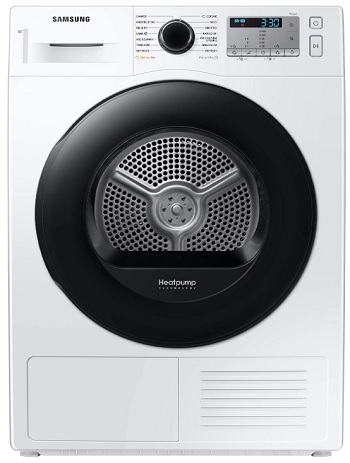
The heat pump technology developed by Samsung is the future of effective laundry drying. Heating the air inside the drum makes it more forgiving to fragile fabrics. And since it uses less power than a standard condenser or vented dryer, it’s easier on your wallet and the planet.
With soaring energy bills and the ever-increasing cost of living, the goal is to use your tumble dryer to dry clothes while using the least amount of energy possible.
With the help of moisture and temperature sensors, the” Optimal Dry” intelligent technology can quickly and accurately determine whether something is dry enough to end the cycle at the most optimal time. This prevents wear and tear on your garments and helps you conserve electricity.
You can place your Samsung Series 5 tumble dryer wherever you choose as long as the door opens and closes without obstruction – no need for external venting. Depending on your preference, the tumble dryer’s reversible door may swing open from the left or the right. Loading and unloading your clothes is a breeze, with large drum and door position options.
How many times have you washed an outfit for work or an event and forgot to dry it? We’ve all been there. When using the 35-Minute Quick Dry cycle, a small 1kg load of laundry may be dried in little more than half an hour.
If you take good care of your dryer, it will last longer and produce better drying results. The 2-in-1 filter helps you maintain your dryer and get the most out of it by collecting fluff and lint, so the heat exchange filter needs less frequent cleaning. And the helpful, clean alert will jog your memory to let you know when the filters require a clean.
If you take good care of your dryer, it will last longer and produce better drying results. The 2-in-1 filter helps you maintain your dryer and get the most out of it by collecting fluff and lint, so the heat exchange filter needs less frequent cleaning. And the helpful, clean alert will jog your memory to let you know when the filters require a clean.
It’s not always necessary to give clothes or bedding a full wash cycle just because they’ve been gathering dust in the cupboard for a while. A quick dust-off and refresh would do. The solution you need is Samsung Air Wash. Throw in your dusty textile and let a mild but heated air cycle remove dust and sanitise your fabrics.
Reduce the time spent ironing by using the dryer’s wrinkle-fighting function. You may avoid wrinkles by switching to the Wrinkle Prevent setting once the dryer has finished its cycle. Additionally, the drum will revolve at a slower speed, thus reducing the risk of the clothing becoming damaged. This will prevent your dry garments from gathering wrinkles from sitting around for too long. Then, you have to grab some clothes, and you’re set to go.
This is the top most energy-efficient tumble dryer available, packed with amazing features and stylish looks, and built by a trusted brand.
- Type of Dryer: Heatpump
- Cycle time: 35min Quick Dry
- Energy Efficiency Class: A
- Noise Level: 65 dB (quiet operation)
- Child Safety lock: Yes
- Drying Load Capacity: 9Kg
Read Next: List of Most Energy-Efficient Washing Machines
3. Beko B5T4923RW 9Kg Heat Pump Tumble Dryer
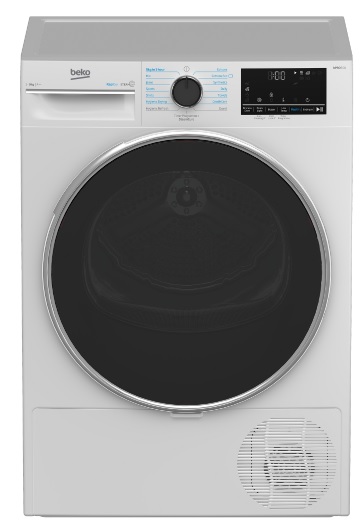
Beko’s sensor drying programmes detect the amount of moisture in the drum and switch off the dryer when the desired degree of dryness has been achieved, avoiding the potential for over-drying and wasting valuable energy. This feature means your laundry will be better protected, and you will save time and money in the process.
Further, drying your laundry at lower temperatures with heat pump technology and recycling hot air inside the drum saves energy and protects your clothing from damage.
The Beko engineers know how annoying it is to have to wait around for your dryer’s lengthy cycle to end. That’s why they designed the lightning-fast “RapiDry” feature so that you can dry as much as 5 kg of clothes in just 60 minutes.
A feature not seen on most dryers is an interior drum light. This light makes loading and unloading your laundry much simpler by illuminating the drum inside, so no sock is ever left behind. The wide 32cm porthole door makes it simpler to load bulky loads, such as bedding and large towels.
An automated anti-creasing feature turns the drum frequently for up to 2 hours after a cycle has ended, separating your clothing so that they’re not left to compress to minimise creases. This is ideal for times when you can’t unload the dryer right away – just leave this feature to work its de-wrinkle magic while you attend to other jobs.
- Drying Weight Capacity 9kg
- Energy Efficiency rating A++
- Includes drum Light
- Includes electronic Child Lock Feature
- Features water Tank Full Indicator
Related: Most Reliable Washer Dryer Combos Compared
4. Top Energy Efficiet Condenser Dryer: Beko DTLCE80121W
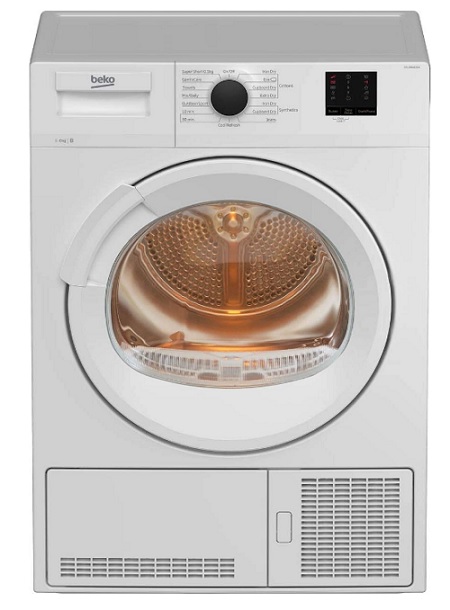
This 8kg condenser tumbler is similar to the Beko 9kg heat pump dryer but has a smaller drum capacity and less visible display and uses a condenser drying system. It has a 12.5-inch porthole, making it ideal for large loads of wet washings.
The sensor drying program automatically stops the cycle once it reaches optimal dryness, protecting your laundry and keeping energy use down to a minimum. This tumble dryer is safe and clear thanks to its LED interior drum lights as well as a child safety feature.
This tumble dryer saves you the effort of emptying the water tank manually by having a drain hose that can be connected to your waste drain pipe to allow for easy and direct water disposal.
With a very respectable B energy rating (B is as low as you can get for a condenser dryer), this dryer is able to handle large loads, and its moisture sensor means you have a condenser tumble dryer that’s low on energy and high on performance, and built by a Beko, a trusted name in laundry appliances.
5. Best Energy Efficiant Vented: Montpellier MVSD7W 7kg
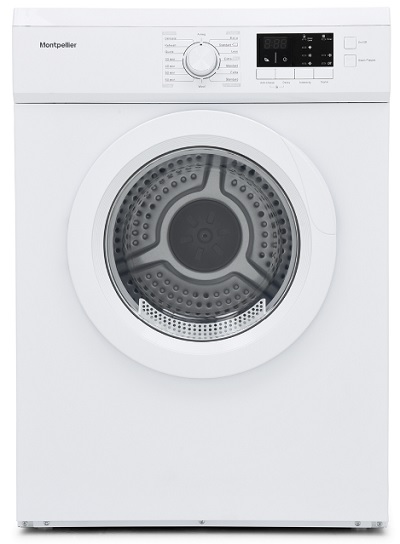
With the Montpellier MVSD7W Tumble Dryer, a full 7kg load of wet washing can be dried in just one session cycle because of its capacity load-bearing motor. It has 16 programs to suit different fabrics and drying loads – Cotton, Synthetics, Mix, Syntehcis with a choice of Refresh, Delicate, Quick, Wool, or Airing mode.
The tumble dryer’s built-in sensor technology detects when clothes are dry enough and automatically ends the cycle, even if there is still time. This allows you to reduce energy consumption, lowering household energy bills and reducing fabric wear and tear.
Using the handy delay start feature, you can set the dryer to dry at a time that suits you. This allows you to set it up for anywhere from 3 hours all the way to 9. This Montpellier dryer also allows you to set an alarm to be notified when the cycle is finished.
- 7Kg Drum Capacity
- 16 Drying Programmes
- 69dB Operational noise level
- Drying Sensor
- Tumble Dryer Type: vented
Do you need a Tumble Dryer?
Not every household needs a tumble dryer. For example, a single person living alone will have far less laundry to tackle compared to a family of five. If you’re only washing and drying one small load per week, then a simple indoor drying rank will suffice and save you a ton on your electricity bill.
Putting a drying rack in the bedroom or the living room is an alternative, but it is unsightly and not practical for larger volumes of drying. There’s also a risk that you’ll encourage mould development if the room is not properly ventilated. Those with large families or infants know how difficult it can be to keep up with the laundry without a dryer; a drying rack just can’t keep up.
Busy working households don’t have time to be bogged down with loads of clothes every day that must be washed, dried, hung, folded, and stored away – it’s time-consuming. There comes a point when assistance is required, and that’s when a tumble dryer comes to the rescue.
But with any large appliance – particularly white goods – there’s a big upfront investment and then running costs. You’ve got to weigh up whether you can afford them. With that said, the top 5 tumble dryers in this guide should help with making that choice easier, since we’re shortlisted the most energy-efficient dryers to help keep your running costs to a minimum.
What Type of Dryer is Best for Energy Efficiency?
For the most part, all types of tumble dryers do the same thing – tumble wet clothing inside a heated drum to dry them. But the type of dryer has a huge impact on energy efficiency.
Tumble dryers can be broken into three types: heat Pump, Condenser, and Vented. Here are how they stack up in terms of their energy ratings.
- Heat Pump (A+++, A++, A+)
- Condenser (A+, mostly B)
- Vented (B, mostly C)
As you can see, a heat pump is the most energy-efficient of the three, with only A plus ratings. The second is condenser with mainly B class models, and the worst for energy consumption are vented tumble dryers with mostly C class machines. Although, class C is still a respectable rating.
Despite heat-pump being the best type of dryer, the condenser tumble dryer is the most widely used. It absorbs the moisture from the wet laundry. The humid air is then cooled with the help of cold ambient air.
The water vapour condenses when the damp air is passed through the condenser unit and finally captured in a tank. After each drying cycle, this is often full and requires emptying. The convenience of a condenser and heat pump tumble dryer is that it may be used anywhere there is an electrical outlet, unlike a vented machine that requires an external ventilation source to expel moist air.
The typical capacity of all machines is 5–10 kg, which is more than enough for most homes, and typically ranks in the A+++ – B energy class, with the exception of some vented, which are mostly C-rated.
An exhaust air or condenser drier uses three or more kilowatt hours of energy per drying operation, assuming a standard drum size. A heat pump-equipped tumble dryer reduces energy use by half or more.
Getting the Most from Your Tumble Dryer
Before putting your wet laundry into the dryer, make sure it is not completely soaked. Ensure the machine has spun the clothes on maximum RPM to squeeze as much water from the laundry as possible. This will mean the dryer won’t have to work as hard to dry them, and the cycle will end quicker. A faster drying cycle means less electricity burned through.
We recommend choosing a dryer that has humidity sensors. These have the advantage that they recognize when the laundry is dry and will stop the machine automatically – avoiding over-drying – saving you time and energy. You should also adjust the size optimally to the household size and only switch on the tumble dryer when it is sufficiently full. A half-empty dryer may be a waste of electrical power when you can handle a full load.
Dryer balls have been shown to enhance drying and shorten the process by up to 25% – with little expense.
Understanding Tumble Dryer Energy Class Labels
The EU or UK energy label is attached to most home appliances. This label holds key information on how much energy the appliance uses, also noise level emissions, weight load limits, and even a QR Code you can scan with your smartphone to access even more info on the appliance.
The classes for the current models range from A+++ to D, in a colour banding – Green being the best, red being the worst.
At first glance, the difference seems very small, but that can be deceptive. In fact, a tumble dryer with energy efficiency class B, for example, uses up to 70% more electricity than a tumble dryer with energy efficiency class A+++.
Experts advise buying at least a Class A dryer to get the lowest energy consumption possible. You will recoup the high acquisition costs of the dryer over the years of use – especially with regard to the constantly increasing electricity costs.
Update: There have been some changes to the energy rating system. Some appliances have removed the plus symbols and just have an “A” instead.
Twenty years ago, when energy labels were initially introduced, the grading scheme was very straightforward. An A for appliances that use the least energy and an F for those that use the most. But as new, more effective products started to appear, things became a bit complicated. Because of this, we now have a variety of ratings, including A+, A++, and even A+++.
More and more appliances eventually fell into the A+ to A+++ category as they improved over time. As a result, it was more difficult to determine which appliances were genuinely using less energy. This new modification removes the uncertainty. Now, ratings for appliances go from A to G to keep things simple.

